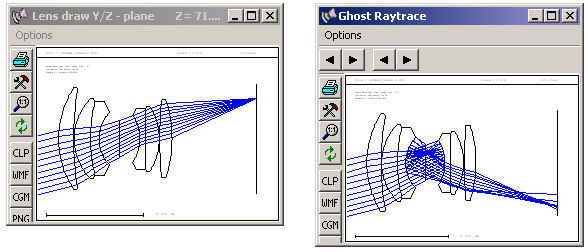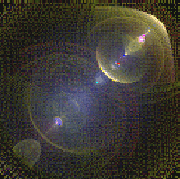Maker of the Optical Design Software OpTaliX
Ghost Image Analysis
Ghost image analysis is based on the built-in inverse ray trace algorithm, which does not require to rebuild the optical system, that is inserting and duplicating surfaces which represent the ghost path. This allows instantaneous ghost analysis and a very fast way to identifying the most disturbing surface combinations.
| Conventional Ray Trace | Ghost Ray Trace |
Ghost Images are due to the fact that optical systems can form unintended images due to reflections between pairs of surfaces. All lens surfaces reflect light to an extent depending on the refractive index of the glass itself respectively on the type of anti-reflection coating applied to these surfaces. Light reflected from the inner surfaces of a lens will be reflected again and may form reasonably well-defined images close to the image surface. Such spurious images are called ghost images.
The number of possible surface combinations (pairs) which may contribute to ghost images is n(n-1)/2, where n is the number of lens surfaces in the system. As the number of surfaces grows, the probability of ghost problems also increases. For example, a zoom lens with 10 lenses (20 surfaces) gives 190 possible ghost images.
Photorealistic Rendering of Ghosts:
OptaliX provides the most realistic and accurate ghost analysis. It offers a fully automatic search of ghost effects by evaluating ALL possible surface pairs in a lens which may contribute to ghosts. That includes wavelength dependent effects of multilayer coatings on optical surfaces, material absorption and vignetting. The image below is the rendered ghost image on a 10-lens element objective including AR-coatings and absorption in lenses. |
Unlike in other optical design programs, OpTaliX does not require a preselection of the most
disturbing ghost surface pairs on a paraxial basis (which can be extremely misleading, if not
totally wrong), nor does it require to rebuild a design for each individual ghost surface pair, writing macros,
storing massive ray data to files and/or display the data with the help of external programs,
as required in other software packages. OptaliX entirely avoids such tedius and inefficient work! Note that the image to the left was rendered from the scratch in about 20 minutes on a 1.7GHz Pentium machine, including all (184) surface combinations, AR-coatings and absorption effects, whereas in other programs you will need hours or days for creating and testing macros and program interfaces. |
Ghost Raytrace in GRIN Elements:
This example shows the ghost raytrace in a radial GRIN element (SelfocTM rod) where the first reflection takes place on surface 3 and the second reflection takes place on surface 2. The surface numbers indicate that additional dummy surfaces are NOT required to simulate the ghost path. This way, ghost analysis is instantaneous.
Overview
Examples
- Non-Sequential
- Special Apertures
- Gradient Index
- Hologram
- Zoom
- Array Surfaces
- Fresnel Lens
- Light Pipe
- Global References
- Geometric Analysis
- Diffraction Analysis
- Interferogram
- Physical Optics (350kb)
- Fibers
- Optimization
- User Defined Graphics
- Glass Manager
- Coatings
- Macro Language
- ISO Element Drawing
- Surface Deformations
- Ghost Image Analysis
- Illumination